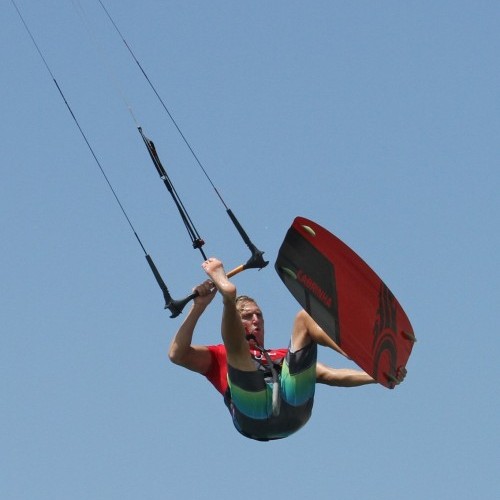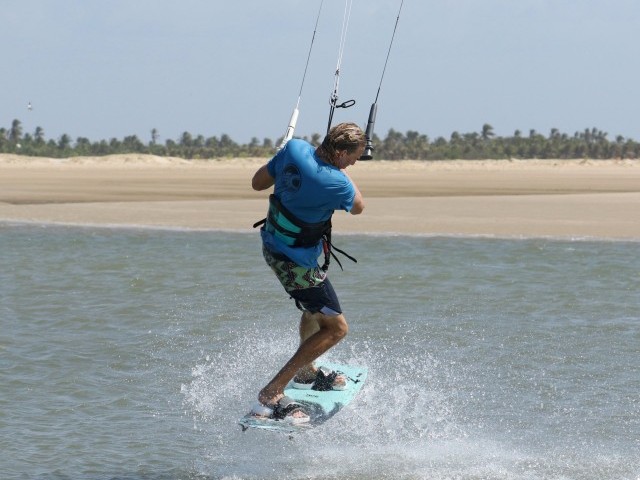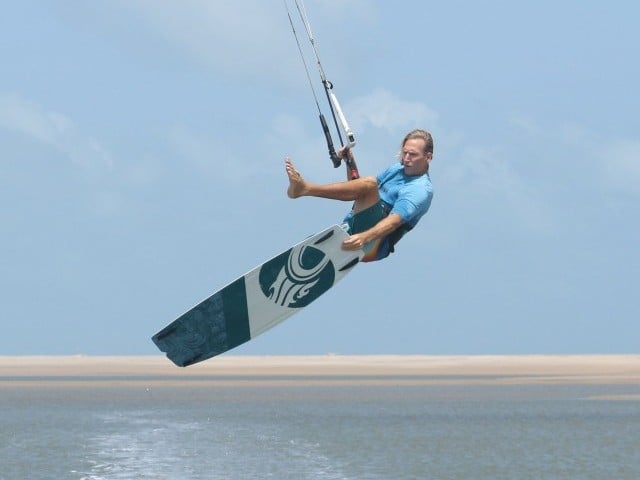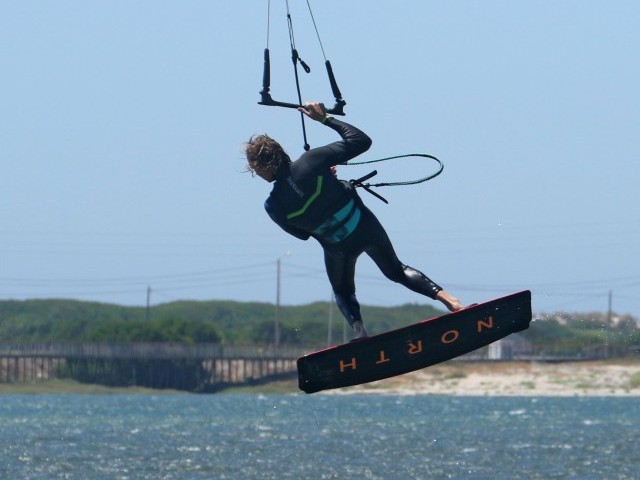
Front Foot One Foot Front Loop
Technique / Intermediate
Introduction
A few issues back we covered the front foot one foot jump, this time round we’ll be looking at adding a front rotation into the mix. Although based around this most cheeky of foot outs, combining it with a front loop/roll brings about a new set of challenges, namely controlling both the kite and your rotation. So let’s not beat around the bush, but rather get into the nitty gritty of this rather long named spectacle.
The first part of this is getting the jump right. You’ll need some height, so that you have a suitable amount of time on your hands to rotate slowly enough that you can get the foot out and back in, and of course you’ll want float so that you’re suspended all the while with no sudden and surprising changes in altitude! With this in mind lets ponder getting airborne.
The Send & Edge
To send yourself up into the skies with enough control you’ll need a decent edge and a hefty send. For the edge concentrate on not pulling the bar in past the sweet spot, otherwise you’ll be pulled off downwind. Make sure that you resist well, hips back, shoulders twisted, back leg flexed but solid so that you are driving all the power through your back heel. For the send make sure you use both hands to steer the kite so that it moves quickly from just below 1 or 11 o’clock up past 12. The combination of these two elements will make for an elevator type jump with little downwind ping. Here Christian has a good, solid edge. He’s looking over his shoulder whilst resisting hard with his legs and sending the kite aggressively around the sweet spot.
The Take Off
If you get the edge and send right then this next stage is the make or break bit. You want to take off with your kite already controlled and where you want it so that you don’t need to do too much whilst flying, and you need to set your front rotation in motion so that it’s slow and controlled. Look at Pic B where you will see that Christian’s back leg is extended whilst his front leg is bent up. This is the result of him kicking hard upwind against his edge and moving his head forward towards his front shoulder as he took off. This should be enough to set his rotation in motion. Notice how his shoulder is not tipping down and his head is not looking around yet. He doesn’t want to spin fast and neither do you. Also, note how Christian has pulled the bar in level, to get the kite to its flying position just behind 12 o’clock. If the kite goes too far back as per a normal jump it’ll be difficult to redirect it enough from the position that you will be in.
The Grab
As soon as the kite is still and you’re on the way up it’s time to get the tail grab. If you’re going up quickly the pull will be extending you, so focus on lifting your knees in an effort to get the board near, lifting the back knee higher so that you can reach the grab whilst keeping the front of the board a tad lower to help free the front foot. Christian is freeing his front foot, looking for the tail grab and he’s released his back hand. The bar is still level and in just past the sweet spot to keep tension and therefore float in the kite. Note that up to this point how slow the rotation is, Christian hasn’t even turned 90˚ yet.
Free The Foot
If your foot is loose-ish in the strap you should be able to free it by pulling the tail both up and in towards you. This will twist the board off your front foot. As your foot comes out try to extend your leg up, which in turn will lean you back and help continue the rotation. You can see that Christian still has the bar in for support, he’s holding the tail in and is pushing his free foot away.
Foot In
As you come around from facing upwind you should think about getting your foot back in. Looking at the photo you can see that Christian is looking at the front strap so that he can guide his foot in. He’s also holding the grab tight, this way he can both push his foot in using his leg and push the board on using his hand. Make sure that you get your foot back in, as if your heel is hanging over the footpad you’ll find landing very difficult. Once the foot is in turn your head so that you can spot your landing, which will guarantee that you finish off your rotation
Landing
Due to your position in the air you’ll rotate around under the bar, which may feel awkward at first, but the usual rule applies and that is to land you need to dive the kite hard down through the window. If you don’t you’ll likely over rotate, as you’ll be forced to let the bar out. Christian has dropped his legs and the board ready for landing and is pulling hard on the front hand to dive the kite – bingo.
Top Tips
We said it at the beginning and we’ll say it again now, it’s about flying the kite above you so that you have support, whilst rotating slowly so that you have time. Think of it as a two part front loop, two lots of 180˚ rather than one continuous motion.
Have a look at the sequence and videos for the Full Monty action.
Common Problems
Not getting your foot out. As with many foot outs or board offs, if you’re not comfortable jumping with loose straps make sure that you wiggle your foot loose before setting up for the jump.
Landing with no power and sinking. This is the classic due to the position you end up in. You mustn’t send the kite too far back so think more of a bow type jump; short, sharp send and then pull the bar. Also, make sure that when you dive the kite at the end that you not only pull down on the bar but that you also use your wrist to steer the kite.
If you’re over rotating take a step back and practice some slow front loops.
Keystones
- Wiggle foot free, send hard and edge well.
- Move head and shoulders forward as you stamp up into your front.
- Immediately get kite still just behind 12 o’clock, lift legs.
- Twist board off front foot and extend leg.
- Foot in and turn to complete rotation – dive hard.
This technique article was in Issue 51 of IKSURFMAG.
Related
By Christian and Karine
Christian and Karine have been working together as a coaching team, running improver to advanced kitesurfing clinics since 2003.



























